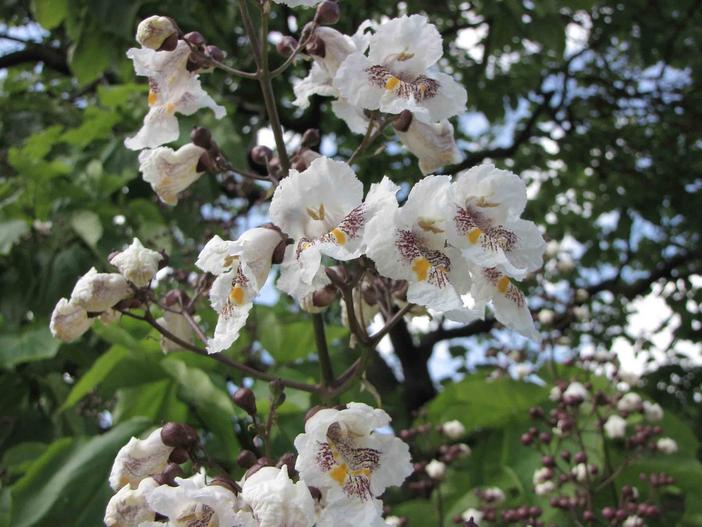Yellow Catalpa
(Catalpa ovata)
Yellow Catalpa (Catalpa ovata)
/
/

阿橋花譜 HQ Flower Guide
CC BY-SA 2.0
Image By:
阿橋花譜 HQ Flower Guide
Recorded By:
Copyright:
CC BY-SA 2.0
Copyright Notice:
Photo by: 阿橋花譜 HQ Flower Guide | License Type: CC BY-SA 2.0 | License URL: https://creativecommons.org/licenses/by-sa/2.0/ | Uploader: 阿橋 KHQ | Publisher: Flickr







































Estimated Native Range
Summary
Catalpa ovata, commonly known as Yellow Catalpa or Chinese Catalpa, is a deciduous tree native to forest margins, stream banks, and limestone hills in China and Mongolia. It grows moderately to a typical height of 20 to 30 feet (6 to 9 meters), with a broad, irregular crown that provides light shade. The tree is known for its showy inflorescences, which are 4–10 inches long (100–250 mm) clusters of creamy white flowers with a distinct yellow tinge. Each flower is approximately 1 inch (25 mm) wide, blooming profusely in July and August. The tree also produces long, slender seed pods that persist into winter, adding visual interest. The bark is relatively smooth and light brown, providing some textural contrast in the landscape.
Yellow Catalpa is valued for its ornamental flowers, tolerance of urban pollution, and its ability to adapt to a range of soil conditions. It is often used in urban plantings, as a specimen tree in gardens, and occasionally for reforestation projects. While it prefers full sun to part shade, it is adaptable to various water levels and soil types, including those with slow to fast drainage. However, gardeners should be cautious as Catalpa ovata can be potentially invasive outside its native range, particularly in parts of the United States. It is less commonly cultivated than its relative, Catalpa bignonioides, but several cultivars exist, such as ’Aurea’, which has golden-yellow foliage. Potential problems include catalpa sphinx moth caterpillars, which can defoliate trees, although this is rarely fatal.CC BY-SA 4.0
Yellow Catalpa is valued for its ornamental flowers, tolerance of urban pollution, and its ability to adapt to a range of soil conditions. It is often used in urban plantings, as a specimen tree in gardens, and occasionally for reforestation projects. While it prefers full sun to part shade, it is adaptable to various water levels and soil types, including those with slow to fast drainage. However, gardeners should be cautious as Catalpa ovata can be potentially invasive outside its native range, particularly in parts of the United States. It is less commonly cultivated than its relative, Catalpa bignonioides, but several cultivars exist, such as ’Aurea’, which has golden-yellow foliage. Potential problems include catalpa sphinx moth caterpillars, which can defoliate trees, although this is rarely fatal.CC BY-SA 4.0
Plant Description
- Plant Type: Tree
- Height: 20-30 feet
- Width: 20-30 feet
- Growth Rate: Rapid
- Flower Color: White
- Flowering Season: Spring, Summer
- Leaf Retention: Deciduous
Growth Requirements
- Sun: Full Sun, Part Shade
- Water: Medium
- Drainage: Slow, Medium, Fast
Common Uses
Bee Garden, Bird Garden, Butterfly Garden, Deer Resistant, Showy Flowers
Natural Habitat
Forest margins, stream banks, and limestone hills in China and Mongolia
Other Names
Common Names: Yellow Catalpa, Japanese Catalpa, Kleinblütiger Trompetenbaum, Catalpa De Chine, Catalpa Jaune, Kinesisk Katalpa, 개오동, 개오동나무
Scientific Names: , Catalpa ovata, Catalpa kaempferi, Catalpa nana, Catalpa henryi, Catalpa ovata var. flavescens, Catalpa bignonioides var. kaempferi, Catalpa himalayaca, Catalpa himalayensis, Catalpa wallichiana,
GBIF Accepted Name: Catalpa ovata G.Don